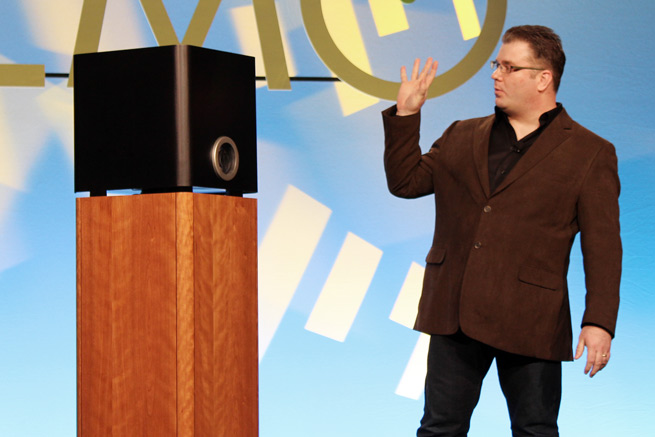
As both a filmmaker and a ex-projectionist, Justin Evans (pictured) knows that movie theater projectors are screwed up. So he co-founded Brytewerks to create the world’s most powerful digital projector that is much simpler to use than existing equipment.
[aditude-amp id="flyingcarpet" targeting='{"env":"staging","page_type":"article","post_id":415162,"post_type":"story","post_chan":"none","tags":null,"ai":false,"category":"none","all_categories":"business,","session":"D"}']If it goes into high gear, the start-up will enable theater owners to get rid of the spaghetti-wired projection systems that they have today. Home theater fans will also be able to set up their homes with simple digital projection systems that are worthy of the theaters, said Evans, in an interview with VentureBeat. If Brytewerks has its way, everyone will be able to hold high-tech movie nights in their backyards or home theaters.
AI Weekly
The must-read newsletter for AI and Big Data industry written by Khari Johnson, Kyle Wiggers, and Seth Colaner.
Included with VentureBeat Insider and VentureBeat VIP memberships.
“Our goal is to put professional media exhibition in the hands of everyone,” he said.
Evans is targeting the Model One at independent musicians, filmmakers, projection mappers, corporate boardrooms, sports bars, churches, and developing-world movie theaters.
Evans is unveiling the Brytewerks Model One digital projector today at the DEMO Spring 2012 conference in Santa Clara, California. Evans has gathered stats that suggest that 3D projectors haven’t paid off because the average theater owner is $65,000 in debt. The Model One is targeted at an estimated 100,000 cinemas throughout the world that need to simplify the projection of movies in digital formats. Evans figures he can save theaters hundreds of millions of dollars with cheaper projectors.
During the DEMO presentation, Evans wasn’t actually able to show the product in action due to the nature of the room and event. However, in the judging panel, DEMO sages were enthusiastic.
“It was shocking to me… at that price,” said Menlo Ventures managing partner Shervin Pishevar. “It sounded amazing.”
Grelock partner James Slavet concurred, saying, “The vision was exciting, and the entrepreneur presented it in an exciting way.”
[aditude-amp id="medium1" targeting='{"env":"staging","page_type":"article","post_id":415162,"post_type":"story","post_chan":"none","tags":null,"ai":false,"category":"none","all_categories":"business,","session":"D"}']
In homes, the Model One will be an all-in-one device that replaces the television with a wall projection unit. It could replace the cable box, video game console, PC, and media storage. The solution costs $2,999 — less than an 80-inch TV.
Brytewerks is in talks with potential customers like Las Vegas show producers and an ad firm in Copenhagen which is considering using them to replace static underground billboards with video walls. The Model One’s cheaper version has a 700-watt bulb and it can project at 6,000 lumens (a measure of brightness). The bulb can be upgraded to a 11,000 lumens version as well. If theater operators want, they can order replacement bulbs.
The self-funded company was founded in 2011 and has three employees. Co-founders include Angelo Artuso and Brent Daniels. Rivals include some 65 manufacturers of projectors, but many of those lack integration with a computer. Evans said the company has crammed a bunch of features into the box which could be 10 times or more less expensive than other projectors. The founders are working in their homes, but they plan to set up an office in Ashland, Oregon.
Evans created an award-winning feature film, A Lonely Place for Dying. He toured 46 film festivals and found during the circuit that every theater had digital projectors that were misaligned and improperly maintained mainly because they had user-hostile interfaces.
[aditude-amp id="medium2" targeting='{"env":"staging","page_type":"article","post_id":415162,"post_type":"story","post_chan":"none","tags":null,"ai":false,"category":"none","all_categories":"business,","session":"D"}']
“I spent more time in projection booths than at parties and began compiling notes on how to build a far better projector, how to focus on the features that mattered, and how to design something incredibly affordable that was still a world-class professional projector,” Evans said. “Only twice was my movie well-projected. We realized that projection was one of the most worst bottlenecks in global multimedia exhibition. We felt this was a market begging for disruption.”
He added, “And when you want to project the Super Bowl on a 20 foot screen in the backyard for all your neighbors you can do that, too.”
Evans grew up working in his parents’ video store, and that exposed him to the business owner’s side of the movie industry. He then got a job as a projectionist at Southgate Cinemas in Portland, Oregon. He remembered how simple the old film reel projections were compared to the modern digital cinemas which require a Frankenstein array of boxes and cables.
“You damn near needed a Ph.D. to make them work,” he said.
[aditude-amp id="medium3" targeting='{"env":"staging","page_type":"article","post_id":415162,"post_type":"story","post_chan":"none","tags":null,"ai":false,"category":"none","all_categories":"business,","session":"D"}']
The Model One is in its final design stage, and it could be in production later this spring.
Brytewerks is one of 80 companies chosen by VentureBeat to launch at the DEMO Spring 2012 event taking place this week in Silicon Valley. After we make our selections, the chosen companies pay a fee to present. Our coverage of them remains objective.
VentureBeat's mission is to be a digital town square for technical decision-makers to gain knowledge about transformative enterprise technology and transact. Learn More